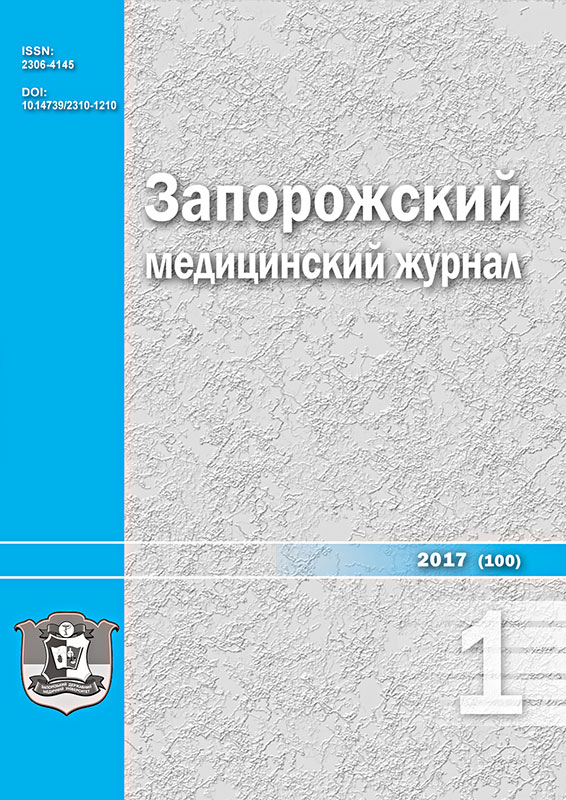Hemodynamic abnormalities of feto-placental complex in influenza virus infection
DOI:
https://doi.org/10.14739/2310-1210.2017.1.91638Keywords:
ultrasonography, influenza virus, pregnant womenAbstract
The aim of the work was to carry out of ultrasound examination of a feto-placental complex in pregnant women who were infected with influenza or infected with influenza at the time of examination.
Materials and Methods. 102 pregnant women were examined. Ultrasound diagnostics of a feto-placental complex, utero-placental, feto-placental blood circulation state has been done by the method dopplerography.
Results. In the first trimester the local hypertonia was revealed in 60,8 % of pregnant women, partial detachment of chorion - in 7,8 %, ovum localization in the bottom departments of uterus - in 48,0 %. In second trimester the general hypertonia was revealed in 71,6 % of monitoring, low placentation - in 58,8 %, placental dysfunction - in 100 %, premature maturation of placenta - in 43,1 %, hypotrophy and hypertrophy of placenta - in 54,9 % and 41,2 % respectively; hydramnion and oligoamnios - in 32,4 % and 16,7 % respectively, partial placental abruption - in 24,5 %, risk of late-term abortion – in 31,4 %, threat of preterm birth – in 36,3 %, fetal growth retardation syndrome - in 52,9 %. In the third trimester the general hypertonia was revealed in 72,5 % of monitoring, partial placental abruption - in 27,5 %, low placentation - in 48,0 %, placental dysfunction - in 100 %, premature maturation of placenta and hypotrophy of placenta - in 45,1 % and 56,9 % respectively, hypertrophy of placenta - in 44,1 %, hydramnion and oligoamnios - in 37,3 % and 17,6 %, fetal growth retardation syndrome - in 59,8 %. Disturbance of utero-placental blood circulation was diagnosed in 52,9 % of cases, feto-placental blood circulation - in 70,6 %, acute fetal distress - in 29,4 %, chronic fetal distress - in 70,6 %.
Conclusions. Ultrasound examination of feto-placental complex in pregnant women who were infected with influenza or infected with influenza at the time of examination has shown that the pregnancy was accompanied by high frequency of obstetric and perinatal complications. This method permits to reveal the risk of complications development timely.
References
Shekhtman, M. M., & Pologenkova, L. A. (2005). Ostrye respiratornye zabolevaniya u beremennyh [Acute respiratory infections in pregnant women]. Ginekologiya, 2(10), 96–99. [in Russian].
Banfiidy, F., Acs, N., Puho, E. H., & Czeizel, A. E. (2008). Мaternal acute respiratory infectious diseases during pregnancy and birth outcomes. Eur. J. Epidemiol, 23(1), 29–35. doi: 10.1007/s10654-007-9206-2.
Lazoryshynets, І. V., Shpak, I. V., Kaminskyi, V. V., Boris, A. N., Onishchyk, L. N., & Serbeniuk, А. V. (2010). Hostra respiratorna virusna infektsiia u vahitnykh: epidemiolohiia, patohenez, osoblyvosti klinichnoho perebihu, suchasni metody diahnostyky i likuvannia [Acute respiratory viral infection in pregnancy: epidemiology, pathogenesis, clinical features, advanced diagnostic and treatment methods]. Zdorov´e zhenshchini, 3(49), 97–101. [in Ukrainian].
Voronin, K. V., & Loskutova, Т. А. (2008). Akusherskie i perinatal'nye oslozhneniya pri zaderzhke vnutriutrobnogo razvitiya ploda [Obstetric and perinatal complications of intrauterine growth retardation]. Zbirnyk naukovykh prats Asotsiatsii akusheriv-hinekolohiv Ukrainy, (P. 61–64). Kyiv: Intermed. [in Ukrainian].
Zaporozhan, V. N., Mishchenko, V. P., & Rudenko, I. V. (2011). Suchani pohliady na diahnostyku hestatsiinykh uskladnen [Modern views on the Look diagnosis of gestational complications]. Zbirnyk naukovykh prats Asotsiatsii akusheriv-hinekolohiv Ukrainy, (P. 369–372). Kyiv: Intermed. [in Ukrainian].
Korostil, M. O. (2010). Osoblyvosti perebihu vahitnosti, polohiv ta neonatalnoho periodu za naiavnosti syndromu zatrymky rostu ploda [The course of pregnancy, childbirth and neonatal period in the presence of fetal growth retardation]. Zbirnyk naukovykh prats Asotsiatsii akusheriv-hinekolohiv Ukrainy, (P. 615–619). Kyiv: Intermed. [in Ukrainian].
Sidorova, I. S., & Makarov, I. O. (2000). Fetoplatsentarnaya nedostatochnost´. Klinicheskie aspekty [Placental insufficiency. Clinical aspects]. Moscow: Znanie-М. [in Russian].
Sytnikova, V. O., Chepras, L. V., & Reznichenko, V. M. (2008). Diahnostyka perynatalnoho infikuvannia u vahitnykh z platsentarnoiu dysfunktsiieiu [Diagnosis of perinatal infection in beremennіh with placental dysfunction]. Zbirnyk naukovykh prats Asotsiatsii akusheriv-hinekolohiv Ukrainy, (P. 568–571). Kyiv: Intermed. [in Ukrainian].
Downloads
How to Cite
Issue
Section
License
Authors who publish with this journal agree to the following terms:
- Authors retain copyright and grant the journal right of first publication with the work simultaneously licensed under a Creative Commons Attribution License that allows others to share the work with an acknowledgement of the work's authorship and initial publication in this journal.

- Authors are able to enter into separate, additional contractual arrangements for the non-exclusive distribution of the journal's published version of the work (e.g., post it to an institutional repository or publish it in a book), with an acknowledgement of its initial publication in this journal.
- Authors are permitted and encouraged to post their work online (e.g., in institutional repositories or on their website) prior to and during the submission process, as it can lead to productive exchanges, as well as earlier and greater citation of published work (See The Effect of Open Access)

